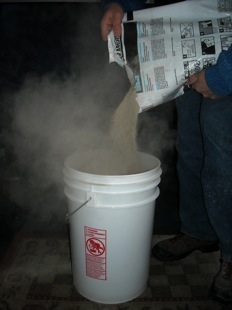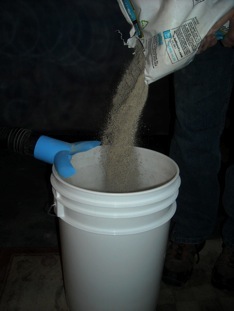When Simple Is Better…A “Medical Device” that Prevents a Certain Type of Asthma?
If you think you need to patent a wildly complex invention to make boat loads of money in the "medical" field, think again. Sometimes simple is better.
Take for example a story I came across while thumbing through the recent issue of Popular Mechanics.
A Medical Device for Prevention
The Popular Mechanics article says…
"Tile-setter Joel Beaton spent 17 years inhaling dust from powdered grout and mortar, which often leads to "potter’s rot," or silicosis, an occupational lung disease marked by asthmatic symptoms. Now Beaton has invented (and patented) an attachment that snaps onto a mixing bucket and keeps dust from escaping. The tool evenly distributes the vacuum’s suction so it draws in the maximum amount of debris. It’s a simple idea, with brilliant results."
After reading the article I visited Beaton’s website, www.waletale.net, and found two pictures that beautifully illustrate how this simple "medical device" sucks grout and mortar dust out of the air, preventing lung problems for tile setters.


Three Rules to Keep in Mind for a Simple Medical Device
If you’re not a Nobel Prize level doctor or have a Phd in biology, anatomy, or an area of medical science – but still want to profit in the world of medical device patents – here are three things to keep in mind.
Medical Device Patent Rule #1: Common Situations that Lead to Health Problem
Many new patents grew from a need to protect workers who are exposed to health risks on a recurring basis.
A few common examples are:
- Gloves for lawn and garden workers so they don’t cut their hands
- Helmets for construction workers so they don’t get knocked out by falling debris
- Surgical masks for doctors and nurses so they don’t breath in germs
- And on and on…
Joel Beaton identified a frequent situation that caused a long term health problem. Look around the type of work you do day in and day out an ask yourself: Who is exposed to constant health risks?
Medical Device Patent Rule #2: Simple Solution
After you’ve identified the problem, here are a few questions you can ask yourself that will help you come up with a simple solution.
Is there something that already exists – that you can tweak a little bit – to fix the problem? In Beaton’s case, he designed a simple attachment for a common worksite tool, the shop vac. Can I make it simple so anyone can use it?
Medical Device Patent Rule #3: Cheap to Produce
If this is your first attempt at patenting an invention, you probably don’t want to bet the bank on it. So design something with as few moving parts as possible (and preferably out of a cheap material like plastic). That way if you get the patent, it will be much less expensive to manufacture and sell.
https://www.medicaldevicepatentattorneys.com/2010/12/when-simple-is-better-a-medical-device-that-prevents-a-certain-type-of-asthma/trackback/
